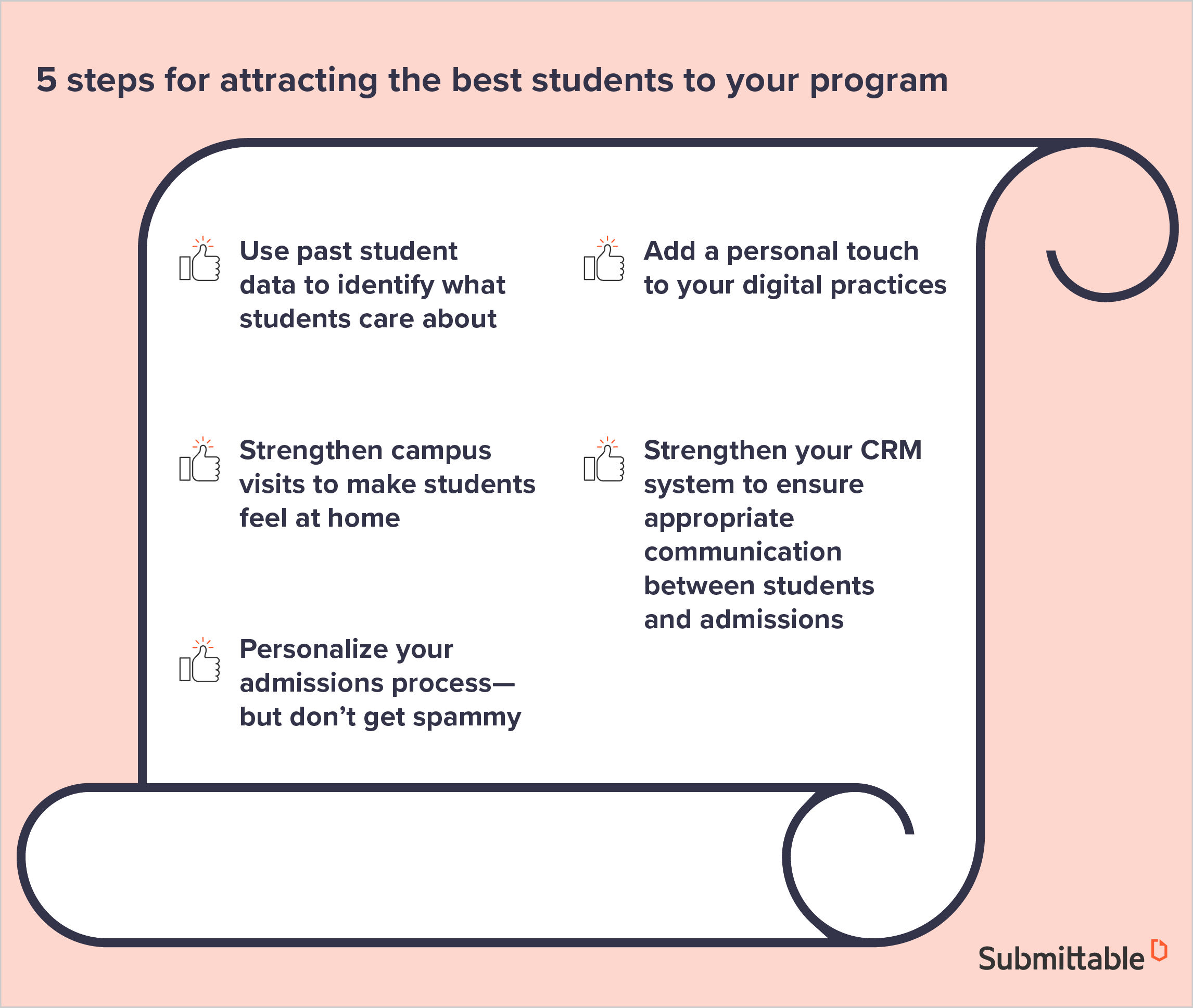2019 was a big year in the headlines for higher education.
From elite university scandals all the way to talk of a national student debt forgiveness, higher education has been the talk of the town. A key topic that ran through many higher education institutions was the struggle colleges are facing with low enrollment.
Smaller colleges, in particular, seemed to be getting hit the hardest. The reasons range from student debt putting students off, to lack of communication from the admissions office and weak career prospects associated with smaller colleges.
A survey by Inside Higher Ed discovered that 90% of admissions directors say they’re concerned about reaching their enrollment goals for specific programs this year. Another recent report showed that college enrollment has decreased for the eighth consecutive year.
But don’t worry. You won’t be heading that way.
We spoke to a few experts to find out exactly what they’re doing to get the right students onto their programs.
We wanted to know the specific methods and practices they’re using and get an insight into any new advances they’re keeping tabs on.
Here’s what they shared with us:

Use past student data to identify what students care about
For Brian Jones, Director of Admissions at Minnesota State University, “college admissions is increasingly driven by data.”
Jones notes that it’s important to look into factors such as the distance between the campus and the students’ home, which is a growing concern for prospective students. This way, you won’t waste time trying to attract students that won’t work demographically and you can focus on where the real likely candidates are.
“By studying behaviors of past students, we can identify characteristics that weigh most heavily in students’ decisions about where to attend college,” Jones explains.
At Minnesota State University, the focus is on students who are most likely to have an interest in specific programs at the college and that’s where resources tend to go.
“Behaviors such as visiting campus or stopping to see an admissions counselor when they visit the high school also indicate strong interest from students. We can then communicate directly with those students about the things that are most important to them in their college search,” Jones shares.
Jones also notes that it helps to know what the students are looking for in other colleges, too.
“While we are recruiting students we will also ask them what factors they are considering in their search and then speak to what our campus offers in that area,” he says.
But Jones warns that while data helps to gather the right information, the responsibility falls to representatives of the college.
“Ultimately having faculty that are passionate about their field connect with prospective students interested in their major is one of the most effective ways to find the right fit between a student and our campus,” he says.
Strengthen campus visits to make students feel at home
For Carrie Thompson, Director of Undergraduate Admissions at Clarion University, attracting the right students is all about interpersonal communications.
“College is all about the right fit,” Thompson shares. “We strive to attract students to our campus that are going to thrive not only during their four-year experience—we want to produce successful, strong alumni.”
Most US colleges rely on the tried and true methods of recruiting new students—high school visits, college fairs and emails being standard practice. But for Thompson, finding the right students requires more than that.
Thompson answers the question, “How do you take it to the next level?” by explaining that at Clarion University, everything starts with the campus visit. The day needs to be personal, and the one-size-fits-all approach is outdated, she says.
“Details in your campus visit, from signup, pre-visit information, to parking, the welcome, presentation, and tour all play a factor,” Thompson tells us. Details matter here and students want to feel at home and “understand how they would connect, thrive and envision themselves walking across a graduation stage—that is how you win on attracting the right student to your academic program.”
Personalize your admissions process—but don’t get spammy
As digital technology has put personalized marketing into the forefront of everything we do, it’s no surprise some colleges have been trying to adapt their admissions process to keep up.
While purchasing student lists might still certainly hold its weight, data has started to change the way decisions are made in college admissions, according to Jones at Minnesota State University.
Today’s tech-savvy Millennials and Gen-Zers expect a completely personalized experience, from adverts on a social media site all the way through the college admission process. What they don’t want is to be inundated with generic texts, calls or emails after just curiously clicking on a website for a quick browse.
Rigid, blanket structures are likely to deter interested candidates and move them along to the next option.
Know when to take a step back from communications
While it may seem daunting to find those ‘just right’ moments to reach out, Jones says it’s all about knowing when to step in (and when to step out). He shares that “finding the right balance in the use of technology to engage in a personal way with students, but not invading their social platforms is a difficult and important task in today’s admission process.”
“Artificial intelligence is preferred to direct human interaction at certain critical stages of the recruitment funnel and that causes admissions veterans like myself to re-adjust our perspectives,” he notes.
That means having real-time information about students’ interest in a particular program is no longer a ‘nice to have’ but an absolute must. Jones adds that it’s having the technology to reach out to prospective students at those critical points in their decision making that’s going to save the admissions game (and it’s what students expect).
Next-gen technology has pushed generic marketing to the sidelines and it’s in with personalized and tailored experiences. For Jones, the key is to draw on student data and to employ the technology to reach out to them during the right moments in their decision making.
Add a personal touch to your digital practices
In our next-gen world where technology reigns, it’s the personal touch that attracts the best students, according to Louise Grant, Associate Director of Admissions at Husson University.
“It’s a personal service that helps distinguish a college or university from its competitors,” Grant adds. At Husson, It’s all about maintaining a human level in a society that’s bursting with fast and efficient technology.
Personal and trustworthy guidance is highly valued in the admissions process and that means upfront, transparent processes. Education Conservancy shared a report showing that prospective students and their families tend to look for institutions with a human element that shares philosophies and values similar to their own.
Grant broke it down for us. “The human touch is unexpected and highly valued. Those who rely too heavily on technology while neglecting customer service are setting themselves up for failure.”
At Husson, admissions and faculty are reminded that “the student is not a computer. They need to feel like they come first.”
Strengthen your CRM system to ensure appropriate communication between students and admissions
Students might be the lifeblood of a college or university but let’s face it—they’re easily lost.
Weak communication systems from an institution’s side can leave a student feeling neglected and in lots of cases, enrolling at another college last-minute.
For Thompson, colleges can try to avoid that loss by using a solid customer relationship management (CRM) system to record and track communications between admissions and students. “Utilizing your CRM system to the highest degree is critical for outreach to students,” Thompson advises.
Tracking student information accurately means admissions staff are adequately prepared to reach out to potential students in an appropriate way. Thompson explains that at Clarion, “FITC (first time in college) students will respond differently than transfer students versus returning adults.”
Not having that information to refer to and tailor outreach can lead to awkward and inappropriate communications between admissions and students. Thompson warns that one-size-fits-all communication harms the process and that new digital advances such as tracking email open rates leave no room for error for colleges trying to understand their recruiting populations.
“Communication flows cannot be copy and pasted,” Thompson advises. “You must critically research and understand your population to know what students need and what should be utilized.”
Thompson offers a few tips for better outreach:
- Plan outreach to students while they’re a prospect and keep a close eye on incomplete applications
- If you’re sending text-based messages, include a call to action
- Stay on top of trends—tailor promotion material accordingly
- Print pieces that could lead to “selfie moments” to keep conversations alive
- Bring the experience to life by giving students the opportunity to interact with faculty and campus
Keeping a grasp on your recruitment population is certainly difficult but it’s not immeasurable. By tracking external communications and keeping an eye on the ways different types of students interact with admissions, colleges can plan tailored and stronger outreach to attract the right students.

Attracting the right students by personalizing the admissions process
From revamping tried-and-true marketing methods to tailoring communications to fit the diverse student population, higher education admission officers have a big task ahead of them.
The experts we spoke to all narrowed in on the importance of personalizing the admissions process to speak to student groups directly. In a society where digital technology is king and where college applicants are used to Netflix-level personalization, bland, one-size-fits-all approaches no longer make the cut.
Generic promotions are outdated for this generation of college applicants and prospective students are looking to connect with their future campus. So, whether you start by strengthening your CRM to keep communication relevant or by keeping tabs on critical moments of a student’s application, it’s time to look towards fresher, digital ways to attract the right students onto your program.
And when the applications start rolling in, collect and review them on a flexible admissions management software. On one easy-to-use platform, you can support reviewers and champion students with strong communication tools to keep them engaged throughout the entire process. You can also communicate directly with students who are midway through the application process.
For reviewers, our software takes care of the high-volume repetitive tasks (goodbye to switching between windows and downloading applications) so reviewers can focus on the most important thing—selecting the best talent for your programs.
Attracting the right students
Amidst the decline in college enrollment, more institutions are honing in on ways to attract the right students to their programs. The experts we spoke to each had their own methods for assembling a strong student body, but one approach that stood out was the need for personalization.
Rather than just drawing in on numbers, these colleges and universities focus on building relationships with the students that truly fit their programs. Personalized communications, data-driven technology and making sure campus visits ‘feel like home’ are just some of the ways you can attract the right students to your programs and contribute to a rich learning experience.
